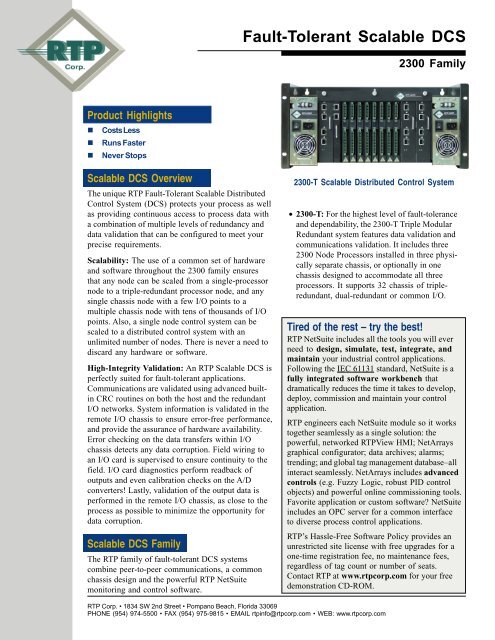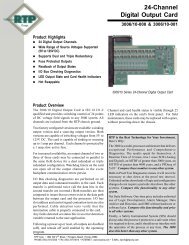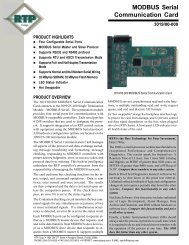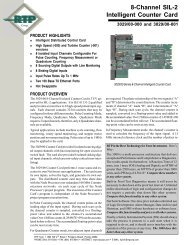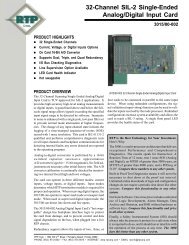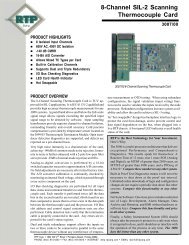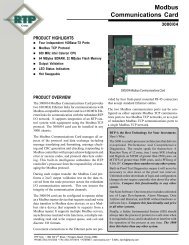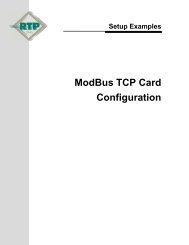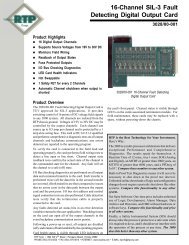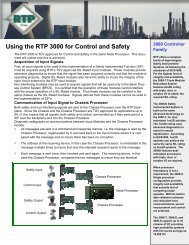Fault-Tolerant Scalable DCS - RTP
Fault-Tolerant Scalable DCS - RTP
Fault-Tolerant Scalable DCS - RTP
Create successful ePaper yourself
Turn your PDF publications into a flip-book with our unique Google optimized e-Paper software.
<strong>Fault</strong>-<strong>Tolerant</strong> <strong>Scalable</strong> <strong>DCS</strong><br />
2300 Family<br />
Product Highlights<br />
Costs Less<br />
Runs Faster<br />
Never Stops<br />
<strong>Scalable</strong> <strong>DCS</strong> Overview<br />
The unique <strong>RTP</strong> <strong>Fault</strong>-<strong>Tolerant</strong> <strong>Scalable</strong> Distributed<br />
Control System (<strong>DCS</strong>) protects your process as well<br />
as providing continuous access to process data with<br />
a combination of multiple levels of redundancy and<br />
data validation that can be configured to meet your<br />
precise requirements.<br />
Scalability: The use of a common set of hardware<br />
and software throughout the 2300 family ensures<br />
that any node can be scaled from a single-processor<br />
node to a triple-redundant processor node, and any<br />
single chassis node with a few I/O points to a<br />
multiple chassis node with tens of thousands of I/O<br />
points. Also, a single node control system can be<br />
scaled to a distributed control system with an<br />
unlimited number of nodes. There is never a need to<br />
discard any hardware or software.<br />
High-Integrity Validation: An <strong>RTP</strong> <strong>Scalable</strong> <strong>DCS</strong> is<br />
perfectly suited for fault-tolerant applications.<br />
Communications are validated using advanced builtin<br />
CRC routines on both the host and the redundant<br />
I/O networks. System information is validated in the<br />
remote I/O chassis to ensure error-free performance,<br />
and provide the assurance of hardware availability.<br />
Error checking on the data transfers within I/O<br />
chassis detects any data corruption. Field wiring to<br />
an I/O card is supervised to ensure continuity to the<br />
field. I/O card diagnostics perform readback of<br />
outputs and even calibration checks on the A/D<br />
converters! Lastly, validation of the output data is<br />
performed in the remote I/O chassis, as close to the<br />
process as possible to minimize the opportunity for<br />
data corruption.<br />
<strong>Scalable</strong> <strong>DCS</strong> Family<br />
The <strong>RTP</strong> family of fault-tolerant <strong>DCS</strong> systems<br />
combine peer-to-peer communications, a common<br />
chassis design and the powerful <strong>RTP</strong> NetSuite<br />
monitoring and control software.<br />
2300-T <strong>Scalable</strong> Distributed Control System<br />
• 2300-T: For the highest level of fault-tolerance<br />
and dependability, the 2300-T Triple Modular<br />
Redundant system features data validation and<br />
communications validation. It includes three<br />
2300 Node Processors installed in three physically<br />
separate chassis, or optionally in one<br />
chassis designed to accommodate all three<br />
processors. It supports 32 chassis of tripleredundant,<br />
dual-redundant or common I/O.<br />
Tired of the rest – try the best!<br />
<strong>RTP</strong> NetSuite includes all the tools you will ever<br />
need to design, simulate, test, integrate, and<br />
maintain your industrial control applications.<br />
Following the IEC 61131 standard, NetSuite is a<br />
fully integrated software workbench that<br />
dramatically reduces the time it takes to develop,<br />
deploy, commission and maintain your control<br />
application.<br />
<strong>RTP</strong> engineers each NetSuite module so it works<br />
together seamlessly as a single solution: the<br />
powerful, networked <strong>RTP</strong>View HMI; NetArrays<br />
graphical configurator; data archives; alarms;<br />
trending; and global tag management database–all<br />
interact seamlessly. NetArrays includes advanced<br />
controls (e.g. Fuzzy Logic, robust PID control<br />
objects) and powerful online commissioning tools.<br />
Favorite application or custom software? NetSuite<br />
includes an OPC server for a common interface<br />
to diverse process control applications.<br />
<strong>RTP</strong>’s Hassle-Free Software Policy provides an<br />
unrestricted site license with free upgrades for a<br />
one-time registration fee, no maintenance fees,<br />
regardless of tag count or number of seats.<br />
Contact <strong>RTP</strong> at www.rtpcorp.com for your free<br />
demonstration CD-ROM.<br />
<strong>RTP</strong> Corp. • 1834 SW 2nd Street • Pompano Beach, Florida 33069<br />
PHONE (954) 974-5500 • FAX (954) 975-9815 • EMAIL rtpinfo@rtpcorp.com • WEB: www.rtpcorp.com
• 2300-D: Built on the same components as the 2300-T,<br />
the 2300-D provides a dual-redundant solution with<br />
advanced diagnostics. The 2300-D features dual-redundant<br />
processors, and up to 32 chassis of triple-redundant,<br />
dual-redundant or common I/O.<br />
• 2300-S: When TMR or dual-processor redundancy is not<br />
a requirement, the 2300-S Single processor configuration<br />
provides integrity and availability, featuring data validation<br />
and redundant host communications. The 2300-S also<br />
supports up to 32 chassis of common, dual-redundant or<br />
triple redundant I/O.<br />
• 2300-M: For small to medium sized systems, the 2300-M<br />
provides a low cost solution using a single processor in a<br />
single chassis. The 2300-M uses a subset of the same<br />
components as the other 2300s, plus the same <strong>RTP</strong><br />
NetSuite.<br />
• <strong>RTP</strong> NetSuite software: Windows-based control and<br />
monitoring software for control logic development,<br />
archiving, alarming, trending and HMI, a central tag<br />
database; PC-based simulation and OPC and DDE<br />
servers. Requires no keys or licenses. Powerful <strong>RTP</strong>View<br />
HMI and SCADA system software included with every<br />
copy of NetSuite.<br />
<strong>Scalable</strong> <strong>DCS</strong> Architecture<br />
Major components of an <strong>RTP</strong> <strong>Scalable</strong> <strong>DCS</strong>-based industrial<br />
control system include the 2300 Target Node(s), an HMI<br />
platform, a development platform, alarm and data archive<br />
platform, and a communications network. With the ability to<br />
support a virtually unlimited number of 2300 Target Nodes,<br />
for simplicity only five 2300 Target Nodes are shown in the<br />
above illustration. Any combination of 2300-T, 2300-D, 2300-<br />
S and 2300-M Target Nodes can be used, allowing any level<br />
of redundancy required for its intended application.<br />
Redundant Host Network: A fast 100 MHz Ethernet network,<br />
identified above as the Redundant Host Network,<br />
provides the communication medium for application development,<br />
operator interface, and data exchange among <strong>RTP</strong> <strong>DCS</strong><br />
Target Nodes. The 2300 <strong>Scalable</strong> <strong>DCS</strong> includes peer-to-peer<br />
capability, allowing the direct transfer of data between target<br />
nodes over the high-speed Ethernet link via TCP (Transmission<br />
Control Protocol). Routing through a host computer, or<br />
the need for slow non-redundant extra cabling, is eliminated.<br />
Only detected changes are exchanged among target nodes,<br />
optimizing overall peer-to-peer communications efficiency.<br />
Use of Ethernet also permits easy connectivity with other<br />
plant floor devices and enterprise systems.<br />
Redundant I/O Network: I/O communications within a<br />
2300 node occur over a dedicated Ethernet network referred<br />
to as the Redundant I/O Network in the diagram. This<br />
ensures that private, dedicated lines carry all data between the<br />
Node Processor and the I/O chassis–ensuring secure transmissions<br />
with the convenience of standard Ethernet connectivity.<br />
Multiple I/O chassis can be placed throughout the plant,<br />
close to field devices. The benefits of this approach are<br />
reduced field wiring and installation costs.
Host Workstations: Under supervision of Microsoft Windows<br />
operating systems, one or more Development Workstations<br />
are used to run the NetSuite Developer Studio. Easy to<br />
use and intuitive in use, its design and graphical layout make<br />
configuration and programming simple. Control application<br />
design and development is augmented with extensive testing<br />
and debugging facilities, including the ability to simulate the<br />
application logic prior to hardware integration. Once developed<br />
and compiled, the control application is downloaded to<br />
the Target Node for execution.<br />
In addition to application development, NetSuite also includes<br />
our human-machine interface application (<strong>RTP</strong>View) and our<br />
alarm monitoring and data archiving application (<strong>RTP</strong>ADA).<br />
Target Node: A 2300 <strong>Scalable</strong> <strong>DCS</strong> Target Node consists of<br />
one, two or three redundant Node Processors housed in any<br />
of a possible 32 intelligent I/O chassis. Each I/O chassis<br />
contains a Chassis Processor and up to 16 hot-swappable<br />
analog, digital or special function I/O cards for almost<br />
unlimited I/O possibilities.<br />
Unique to <strong>RTP</strong> is the use of separate processor modules to<br />
achieve unparalleled system flexibility and performance. The<br />
2300 Node Processors are responsible for all system functions<br />
with the exception of I/O scanning and results voting.<br />
The Chassis Processor executes the I/O scanning, floatingpoint<br />
conversion, and results voting. <strong>RTP</strong> places the results<br />
voting at the I/O chassis to minimize the opportunity for data<br />
corruption and maximize system response, which is so<br />
critical in process control. This design allows <strong>RTP</strong> to take<br />
advantage of an advanced multiprocessor (up to 105 microprocessors<br />
in a 32-chassis system) parallel processing<br />
architecture in a truly distributed fashion unlike prior generation<br />
TMR systems.<br />
Node Processor: The Intel-architecture Node Processor<br />
includes nonvolatile (disk-on-chip) memory, which contains<br />
the target node’s real-time run-time executive (Viking Engine)<br />
and the downloaded control application. Upon power-up or<br />
reset, the Node Processor initialization routines copy the<br />
contents from the disk-on-chip memory into its executable<br />
RAM before entering its run state.<br />
The Node Processor utilizes advanced technology such as<br />
parallel processing, math co-processors and synchronous<br />
DMA mode support, resulting in high-speed logic solving<br />
while simultaneously performing error checking and validation,<br />
I/O calls, peer-to-peer communications and communicating<br />
with the SCADA/HMI operator stations. All I/O values<br />
are reported with each scan to provide a higher level of<br />
integrity than report by exception routines. Peer-to-Peer<br />
communications report by exception to reduce network<br />
traffic; however, the user can define refresh time intervals<br />
where all peer variables are reported. This allows the user to<br />
manage network integrity by balancing network traffic and<br />
data integrity.<br />
The Node Processors contain four Ethernet processors that<br />
are factory-configured to support secure high-speed communications,<br />
such as host, interprocessor and I/O networking.<br />
Each communications port is truly redundant, if a communications<br />
interface fails, the network interface will use another<br />
one of the multiple paths available. Additionally, <strong>RTP</strong> built<br />
advanced error-checking routines in the host, interprocessor<br />
and I/O network structure, ensuring secure and accurate<br />
communications.<br />
High Performance I/O: <strong>RTP</strong>’s specialized I/O cards support<br />
high-integrity applications and/or line supervision for missioncritical<br />
applications. Fast scan rates, true 16-bit A/D precision,<br />
high CMRR (Common Mode Rejection Ratio), over<br />
voltage isolation protection, and superior construction are<br />
several of the advantages that are the hallmark of <strong>RTP</strong> I/O.<br />
<strong>RTP</strong> allows tighter, more accurate control of the process,<br />
with a positive impact on the quality of your product.<br />
<strong>RTP</strong> I/O cards provide a full range of I/O choices: from 5V to<br />
240V AC, 5V to 125V DC, low-level millivolt to +10V, 4-20<br />
mA, thermocouples, RTDs, relays and others. Communications<br />
cards support Modbus serial communications and<br />
Modbus TCP communications for connectivity to devices and<br />
other systems.<br />
<strong>Fault</strong> Tolerance<br />
To provide the highest level of fault-tolerant operation, the<br />
2300 can be configured with redundant Node Processors,<br />
redundant I/O and dual power supply chassis.<br />
Data Integrity: Each 2300 Node Processor solves the logic<br />
and sends the resultant outputs to the associated I/O chassis.<br />
Within the I/O chassis, the Chassis Processor performs data<br />
validation checking and then performs independent voting for<br />
its associated outputs. If the systems outputs are located in<br />
multiple I/O chassis, the voting is distributed over these<br />
chassis.<br />
Distributed voting, performed as close as possible to the<br />
process, enhances integrity by moving potential fault variables<br />
out of the response. Furthermore, results voting at the I/O<br />
chassis level results in a much more responsive, high-speed<br />
system. High-speed processing means more data adjudications<br />
per second, resulting in higher resolution and greater<br />
integrity.<br />
High Availability: If any hardware or network fault occurs,<br />
the operator is notified immediately and the offending Node<br />
Processor is taken offline. Meanwhile, the application continues<br />
to run unaffected on the remaining Node Processor(s).<br />
<strong>RTP</strong>’s hot-swappable components and “easy out” power<br />
supplies, coupled with additional layers of available redundancy,<br />
allow for a quick return to a fully-functional operating<br />
mode.
When the error condition is cleared through online<br />
maintenance activities, non-intrusive reinitialization of<br />
the restored Node Processor takes place, and the<br />
2300 system returns to normal operation.<br />
Signal Validation: Signal validation routines are<br />
supported in all members of the <strong>RTP</strong> <strong>Scalable</strong> <strong>DCS</strong><br />
family, from the 2300-T to the 2300-M. <strong>RTP</strong> signal<br />
validation routines allow for the control of one<br />
logical input produced from up to four redundant<br />
inputs (three hardware and one additional logic).<br />
There are six algorithms that the user can select to<br />
calculate the logical variable from the three physical<br />
field variables. The 2300 <strong>DCS</strong> supports both I/O<br />
card redundancy and sensor redundancy, which is<br />
field-configurable.<br />
Triple Redundant I/O: I/O option cards may have<br />
their inputs or outputs identically configured with<br />
their field wiring connected to the same physical<br />
point, or to identical redundant input sensors. The<br />
Chassis Processors determine which redundant I/O<br />
card is the primary. Only the primary redundant I/O<br />
card drives its analog outputs, the outputs on the<br />
secondary and tertiary cards are armed but isolated<br />
from the field device. Input channels are monitored<br />
from all redundant I/O cards.<br />
Superior Reliability<br />
<strong>RTP</strong> products are designed and are being qualified<br />
under the demanding IEC 61508 standard for<br />
superior reliability, minimal downtime and<br />
maintenance, and a high return on investment.<br />
Specifications<br />
Node Processor<br />
2300-T, -D, -S:<br />
Chassis Processor<br />
2300-T, -D, -S or<br />
Node Processor<br />
2300-M:<br />
Ethernet Cable Type:<br />
Sequence Of Events:<br />
Temperature Ranges<br />
Operating:<br />
Storage:<br />
Humidity Range:<br />
Power Requirements<br />
AC Input Option:<br />
DC Input Option:<br />
Dimensions<br />
16-Slot Chassis:<br />
12-Slot Chassis:<br />
8-Slot Chassis:<br />
Weight<br />
16-Slot Chassis:<br />
12-Slot Chassis:<br />
8-Slot Chassis:<br />
Mobile Intel® Celeron Processor with integrated Intel floating point unit and the<br />
440MX single-component chipset with support for synchronous DMA<br />
2 PCI-based 100 MHz full duplex Ethernet controllers for Host/Inter Processor<br />
communications (2300-T, -D) or redundant Host communications (2300-S)<br />
32 MBytes RAM, 8 MBytes Flash<br />
2 PCI-based 100 MHz full duplex Ethernet controllers for I/O communications<br />
Dedicated processor (PLD) to perform I/O scanning<br />
RISCore 32300 implements Enhanced MIPS-II instruction set<br />
2 PCI-based 100 MHz full duplex Ethernet controllers<br />
32 MBytes RAM, 4 MBytes Flash<br />
STP Category 5 (EIA 568B, Cat 5) shielded Ethernet cables<br />
SOE processing available as an option on all models<br />
–20° to +60°C (–4° to +140°F)<br />
–25° to +85°C (–13° to +185°F)<br />
10% to 95% non-condensing<br />
115V AC @ 2.1A or 230V AC @ 1.1A (External 24V DC input available for I/O cards)<br />
24V DC @ 8A<br />
9.04 inches (22.9 cm) x 19.0 inches (48.3 cm) x 11.3 inches (28.7 cm)<br />
9.04 inches (22.9 cm) x 19.0 inches (48.3 cm) x 11.3 inches (28.7 cm)<br />
8.8 inches (22.4 cm) x 10.0 inches (25.4 cm) x 11.3 inches (28.7 cm)<br />
23 lb. (10.4 kg)<br />
24.7 lb. (11.2 kg)<br />
15.1 lb. (6.8 kg)<br />
Trademark acknowledgments: <strong>RTP</strong> is a registered trademark of <strong>RTP</strong> Corp. All other product or service names mentioned herein are trademarks of their<br />
respective owners. Specifications subject to change without notice.<br />
© 2005 <strong>RTP</strong> Corp. Not for reproduction in any printed or electronic media without express written consent from <strong>RTP</strong> Corp.<br />
All information, data, graphics and statements in this document are proprietary intellectual property of <strong>RTP</strong> Corp. unless otherwise indicated and are to be<br />
considered <strong>RTP</strong> Corp. confidential. This intellectual property is made available solely for the direct use of potential or licensed <strong>RTP</strong> Corp. customers in their<br />
application of <strong>RTP</strong> Corp. products, and any other use or distribution is expressly prohibited. If you have received this publication in error, immediately delete,<br />
discard or return all copies to <strong>RTP</strong> Corp.


